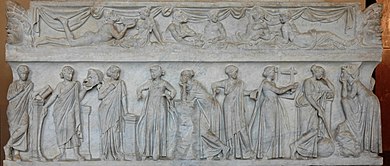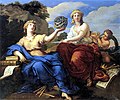There was a worthwhile radio programme from Radio 4 which is clearly relevant to this post.
From Wikipedia, the free encyclopedia

The nine muses — Clio, Thalia, Erato, Euterpe, Polyhymnia, Calliope, Terpsichore, Urania, and Melpomene — on a Roman sarcophagus (2nd century AD, from the Louvre).
In current English usage, "muse" can refer in general to a person who inspires an artist, writer, or musician.[2]
Political allusions to the influential roles that the muse plays within the political sphere[3] has also been referenced in current American literature.
Contents
[hide]Origins[edit]
The earliest known records of the Nine Muses are from Boeotia, the homeland of Hesiod. Some ancient authorities thought that the Nine Muses were of Thracian origin.[4] There, a tradition persisted[5] that the Muses had once been three in number. Diodorus Siculus quotes Hesiod to the contrary, observing:Writers similarly disagree also concerning the number of the Muses; for some say that there are three, and others that there are nine, but the number nine has prevailed since it rests upon the authority of the most distinguished men, such as Homer and Hesiod and others like them.[6]Diodorus also states (Book I.18) that Osiris first recruited the nine Muses, along with the Satyrs or male dancers, while passing through Ethiopia, before embarking on a tour of all Asia and Europe, teaching the arts of cultivation wherever he went.
The Nine Muses, the personification of knowledge and the arts, especially literature, dance and music, are the nine daughters of Zeus and Mnemosyne (memory personified). Hesiod's account and description of the Nine Muses was the one generally followed by the writers of antiquity. It was not until Roman times that the following functions were assigned to them, and even then there was some variation in both their names and their attributes: Calliope (epic poetry), Clio (history), Euterpe (flutes and lyric poetry), Thalia (comedy and pastoral poetry), Melpomene (tragedy), Terpsichore (dance), Erato (love poetry), Polyhymnia (sacred poetry), Urania (astronomy).
Three ancient Muses were also reported in Plutarch's Quaestiones Convivales[7] (9.I4.2–4).[8] The Roman scholar Varro relates that there are only three Muses: one who is born from the movement of water, another who makes sound by striking the air, and a third who is embodied only in the human voice. They were Melete or Practice, Mneme or Memory and Aoide or Song.
In one myth, King Pierus, king of Macedon, had nine daughters he named after the nine Muses, believing that their skills were a great match to the Muses. He thus challenged the Muses to a match, resulting in his daughters, the Pierides, being turned into chattering magpies[9] for their presumption.
Sometimes they are referred to as water nymphs, associated with the springs of Helicon and with Pieris. It was said that the winged horse Pegasus touched his hooves to the ground on Helicon, causing four sacred springs to burst forth, from which the muses were born.[10] Athena later tamed the horse and presented him to the muses.
Antiquity set Apollo as their leader, Apollon Mousagetēs ("Apollo Muse-leader").[11] Not only are the Muses explicitly used in modern English to refer to an artistic inspiration, as when one cites one's own artistic muse, but they also are implicit in words and phrases such as "amuse", "museum" (Latinised from mouseion—a place where the muses were worshipped), "music", and "musing upon".[12]
According to Hesiod's Theogony (7th century BC), they were daughters of Zeus, the second generation king of the gods, and the offspring of Mnemosyne, goddess of memory. For Alcman and Mimnermus, they were even more primordial, springing from the early deities, Uranus and Gaia. Gaia is Mother Earth, an early mother goddess who was worshipped at Delphi from prehistoric times, long before the site was rededicated to Apollo, possibly indicating a transfer to association with him after that time.
Pausanias records a tradition of two generations of Muses; the first are the daughters of Uranus and Gaia, the second of Zeus and Mnemosyne. Another, rarer genealogy is that they are daughters of Harmonia (the daughter of Aphrodite and Ares), which contradicts the myth in which they were dancing at the wedding of Harmonia and Cadmus.
Compare the Roman inspiring nymphs of springs, the Camenae, the Völva of Norse Mythology and also the apsaras in the mythology of classical India.
In myth[edit]

Polyhymnia, the Muse of sacred poetry, sacred hymn and eloquence as well as agriculture and pantomime.
In later tradition, four Muses were recognized: Thelxinoë, Aoedē, Arche, and Meletē, said to be daughters of Zeus and Plusia or of Uranus.
One of the people frequently associated with the Muses was Pierus. By some he was called the father (by a Pimpleian nymph: called Antiope by Cicero) of a total of seven Muses, called Neilo (Νειλώ), Tritone (Τριτώνη), Asopo (Ἀσωπώ), Heptapora (Ἑπτάπορα), Achelois, Tipoplo (Τιποπλώ), and Rhodia (Ῥοδία).[14]
In one myth, the Muses judged a contest between Apollo and Marsyas. They also gathered the pieces of the dead body of Orpheus, son of Calliope, and buried them. In a later myth, Thamyris challenged them to a singing contest. They won and punished Thamyris by blinding him and robbing him of his singing ability.
Though the Muses, when taken together, form a complete picture of the subjects proper to poetic art, the association of specific Muses with specific art forms is a later innovation. The Muses were not assigned standardized divisions of poetry with which they are now identified until late Hellenistic times.
Emblems[edit]
| Muse | Domain | Emblem |
|---|---|---|
| Calliope | Epic poetry | Writing tablet, Stylus, Lyre |
| Clio | History | Scrolls, Books, Cornet, Laurel wreath |
| Euterpe | Music, Song, and Lyric Poetry | Aulos (an ancient Greek musical instrument like a flute), panpipes, laurel wreath |
| Erato | Love poetry | Cithara (an ancient Greek musical instrument in the lyre family) |
| Melpomene | Tragedy | Tragic mask, Sword (or any kind of blade), Club, Kothornos (boots) |
| Polyhymnia | Hymns | Veil, Grapes (referring to her as an agricultural goddess) |
| Terpsichore | Dance | Lyre, Plectrum |
| Thalia | Comedy | Comic mask, Shepherd's crook (the vaudeville act of pulling someone off the stage with a hook is a reference to Thalia's crook), Ivy wreath |
| Urania | Astronomy | Globe and compass |
In Renaissance and Neoclassical art, the dissemination of emblem books such as Cesare Ripa's Iconologia (1593 and many further editions) helped standardize the depiction of the Muses in sculpture and painting, so they could be distinguished by certain props. These props, or emblems, became readily identifiable by the viewer, enabling one immediately to recognize the Muse and the art with which they had become associated.
Calliope (epic poetry) carries a writing tablet; Clio (history) carries a scroll and books; Euterpe (song and elegiac poetry) carries a flute, the aulos; Erato (lyric poetry) is often seen with a lyre and a crown of roses; Melpomene (tragedy) is often seen with a tragic mask; Polyhymnia (sacred poetry) is often seen with a pensive expression; Terpsichore (choral dance and song) is often seen dancing and carrying a lyre; Thalia (comedy) is often seen with a comic mask; and Urania (astronomy) carries a pair of compasses and the celestial globe.
Functions[edit]
In society[edit]
The Muses, therefore, were both the embodiments and sponsors of performed metrical speech: mousike (whence the English term "music") was just "one of the arts of the Muses". Others included Science, Geography, Mathematics, Philosophy, and especially Art, Drama, and inspiration. In the archaic period, before the widespread availability of books (scrolls), this included nearly all of learning. The first Greek book on astronomy, by Thales, took the form of dactylic hexameters, as did many works of pre-Socratic philosophy. Both Plato and the Pythagoreans explicitly included philosophy as a sub-species of mousike.[16] The Histories of Herodotus, whose primary medium of delivery was public recitation, were divided by Alexandrian editors into nine books, named after the nine Muses.
For poet and "law-giver" Solon,[17] the Muses were "the key to the good life"; since they brought both prosperity and friendship. Solon sought to perpetuate his political reforms by establishing recitations of his poetry—complete with invocations to his practical-minded Muses—by Athenian boys at festivals each year. He believed that the muses would help inspire people to do their best.
Invoking the Muse in Literature[edit]
Originally, the invocation of the Muse was an indication that the speaker was working inside the poetic tradition, according to the established formulas. For example:
- Homer, in Book I of The Odyssey:
- "Sing to me of the man, Muse, the man of twists and turns
- driven time and again off course, once he had plundered
- the hallowed heights of Troy." (Robert Fagles translation, 1996)
- Virgil, in Book I of the Aeneid:
- O Muse! the causes and the crimes relate;
- What goddess was provok'd, and whence her hate;
- For what offense the Queen of Heav'n began
- To persecute so brave, so just a man; [...]
- (John Dryden translation, 1697)
From cults to modern museums[edit]
Often Muse-worship was associated with the hero-cults of poets: the tombs of Archilochus on Thasos and of Hesiod and Thamyris in Boeotia all played host to festivals in which poetic recitations accompanied sacrifices to the Muses. The Library of Alexandria and its circle of scholars formed around a mousaion ("museum" or shrine of the Muses) close to the tomb of Alexander the Great. Many Enlightenment figures sought to re-establish a "Cult of the Muses" in the 18th century. A famous Masonic lodge in pre-Revolutionary Paris was called Les Neuf Soeurs ("the nine sisters", that is, the nine Muses) - Voltaire, Benjamin Franklin, Danton, and other influential Enlightenment figures attended it. As a side-effect of this movement the word "museum" (originally, "cult place of the Muses") came to refer to a place for the public display of knowledge.
Gallery[edit]
See also[edit]
- Apsara
- Artistic inspiration
- Divine inspiration
- Leibethra
- Pimpleia
- Saraswati
- Muses in popular culture
References[edit]
- Jump up ^ From which mind and mental are also derived; see Oxford English Dictionary.
- Jump up ^ "muse". The Merriam-Webster Online Dictionary. Retrieved February 15, 2009.
- Jump up ^ "Politics and the Muse".
- Jump up ^ "The Growth of Literature".
- Jump up ^ Reported to Pausanias in the second century AD (noted in Karl Kerenyi, The Gods of the Greeks, 1951, p.104 and note 284. Kerenyi offers the suggestion, from Hesiod's own practice, that their names had been Melete, "practicing", Mneme, "remembering", and Aoide, "singing".
- Jump up ^ Diodorus Siculus, 4.7.1–2 (on-line text)
- Jump up ^ it:Plutarco
- Jump up ^ Diodorus, Plutarch and Pausanias are all noted by Susan Scheinberg, in reporting other Hellenic maiden triads, in "The Bee Maidens of the Homeric Hymn to Hermes" Harvard Studies in Classical Philology, 83 (1979:1–28) p. 2.
- Jump up ^ Ovid, Metamorphoses 5.677–78: "Now their previous eloquence also remained in the birds, as well as their strident chattering and their great zeal for speaking." See also Antoninus Liberalis 9.
- Jump up ^ "Elysium Gates - Historical Pegasus".
- Jump up ^ For example, Plato, Laws 653d.
- Jump up ^ OED derives "amuse" from French a ("from") and muser, "to stare stupidly" or distractedly.
- Jump up ^ Pausanias, Description of Greece 9.29.1.
- Jump up ^ "TheoiProject: Muses". Theoi.com. Retrieved 2014-06-20.
- Jump up ^ Tzetzes, Scholia in Hesiodi Opera 1,23
- Jump up ^ Strabo 10.3.10.
- Jump up ^ Solon, fragment 13.
External links[edit]
| Wikisource has the text of The New Student's Reference Work article Muses. |
 The dictionary definition of Muse at Wiktionary
The dictionary definition of Muse at Wiktionary Media related to Muses at Wikimedia Commons
Media related to Muses at Wikimedia Commons- Muses in the ancient art
- Warburg Institute Iconographic Database (ca 1,000 images of the Muses)
| ||
| ||
| ||
|

















